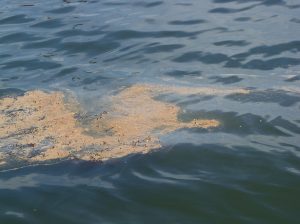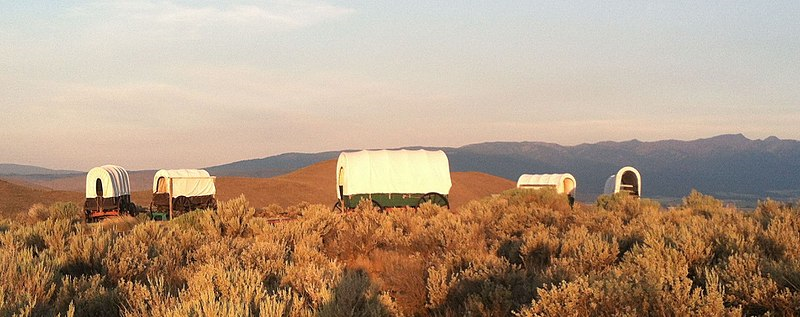Chemistry is a subject that I really don’t think much about, and haven’t studied since high school. Yet recently, reading Capra and Luisi’s compendious book on systems theory, I found myself really enthralled by a piece of chemistry. It was an explanation, at a molecular level, of how self-organisation occurs. Self-organisation, or autopoiesis, is the rather mysterious property of living things to form themselves into a relatively independent, self-sustaining system, setting up a boundary against their environment and maintaining their existence within that boundary. We do it. Single cells do it. But how do they do it? It turns out that even non-living molecules can do it, and their ability to do so seems to give us some basic clues not just about systems, but also about the Middle Way.
The chemical experiment you can do is extremely simple: just evenly distribute some oil over some water. After a short time, as every witness of the Deepwater Horizon or other such disasters knows, the spread out oil will clump. It will clump a bit faster if the water is warmer. I had never wondered before exactly why it clumps, but it turns out that the reason it clumps is that oil molecules are polarised. One end of them is hydrophilic (water loving) and the other end hydrophobic (water hating). Thus, purely through the agitation of molecules produced by warmth, the hydrophobic ends will be attracted to each other rather than the water, and clump together with their hydrophilic ends pointed outwards, like a circle of wagons in an old Western as the Indians approach.
What I found fascinating about this is that it shows how self-organisation can happen quite straightforwardly at a simple chemical level. The oil molecules have effectively organised themselves into what is technically known as a micelle – more commonly known as an oil droplet. They have set up a boundary so as to sustain themselves against their environment, just like we do. It is also very interesting that they do so through polarisation: this behaviour is only possible because of the contrasting tendencies of each end of the molecule, which in turn is due to the asymmetrical chemical structure of these molecules. Those drops of oil immediately reminded me of human behaviour where polarisation also produces defensive clumping: say, Trump supporters on the internet. The Trump supporters have liberal-phobic heads and liberal-philic tails, so in a liberal environment they will clump their heads together, leaving their tails to face the wider environment. Of course, one can stretch this analogy too far. Trump supporters are living human beings, far more complex and varied than oil molecules. But the resemblance tells us something about a basic pattern that can apparently be applied at many different levels.
The self-organisation process also involves closed feedback loops as opposed to open ones. In a closed feedback loop, the same kind of response to a stimulus keeps getting repeated so as to exaggerate the total effect in one unbalanced direction. The oil molecules are in a closed feedback loop because whenever they encounter another such molecule they form this defensive formation. The oil molecules are not capable of open feedback loops, because they are rigidly polarised. They can’t change their behaviour so as to mingle freely with the water. You can stir them up to break up the clumps, but as soon as they encounter new oil molecules their polarisation will make them clump together again. If one can talk of oil molecules having beliefs, they have absolute beliefs. They will carry right on doing the same thing regardless.
We living organisms are far more flexible than that, because we all contain some tendencies towards polarisation, but also some capacity for open feedback loops, whereby we allow conditions beyond our boundaries to modify our structure. To do that we will have to avoid polarisations of response whereby we always reject or embrace a given condition, and allow more complex responses. A constant movement between closed and open feedback loops is part of our most basic behaviour. At the complex level we have evolved into, the left hemisphere of the brain specialises in the closed feedback loops, maintaining rigid beliefs about our environment, whilst the right specialises in stimulating modifications of the left.
Oil molecules can’t follow the Middle Way – they are stuck in absolutisations. But we can. The more emergent complexity we develop through open feedback loops stimulating and changing us at helpful points in our development, the greater the capacity we can develop for avoiding polarisation and responding in different ways to different stimuli. Life is sometimes about rigid insistence, but also sometimes about flexible adaptation. But it is that flexible adaptation that produces emergent properties like representation, consciousness, judgement, responsibility and moral awareness: properties that we can neither assume emerged magically from somewhere else, nor that they are only the sum of their simpler parts. Any fool can circle the wagons to fight off the Indians, but it takes emergent awareness to question that defensive response, talk to them and even learn from them. 
Click to read the previous post on systems theory and the Middle Way
Pictures of oil slick and wagon circle both public domain
